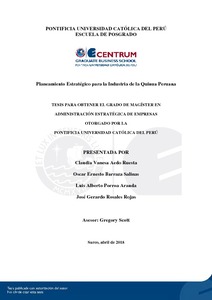| dc.contributor.advisor | Scott, Gregory | |
| dc.contributor.author | Aedo Ruesta, Claudia Vanesa | es_ES |
| dc.contributor.author | Barraza Salinas, Oscar Ernesto | es_ES |
| dc.contributor.author | Porroa Aranda, Luis Alberto | es_ES |
| dc.contributor.author | Rosales Rojas, José Gerardo | es_ES |
| dc.date.accessioned | 2018-04-24T14:17:54Z | |
| dc.date.available | 2018-04-24T14:17:54Z | |
| dc.date.created | 2018 | |
| dc.date.issued | 2018-04-24 | |
| dc.identifier.uri | http://hdl.handle.net/20.500.12404/11949 | |
| dc.description.abstract | Este planeamiento estratégico tiene como principal objetivo alcanzar la visión trazada para el
desarrollo de la industria de la quinua y sus derivados en el país al 2027, el cual se concretará
a través de la interacción de dos puntos primordiales: los objetivos de largo plazo y las
estrategias a aplicar. Ambos han sido obtenidos en base a un análisis objetivo de información
seleccionada, que ha permitido establecer: (a) el contexto global de la industria de la quinua,
mediante la identificación de los principales referentes y competidores en el cultivo de quinua
y la producción de derivados, tanto en Sudamérica como en el mundo; y (b) el análisis
interno, con el objetivo de determinar las regiones en el país con mayor potencial para la
producción de quinua, tales como Puno, Arequipa, Ayacucho, y, debido a la demanda, en
zonas de la costa como Lambayeque y La Libertad. Estos resultados han sido obtenidos a
partir del diagnóstico de la situación actual del cultivo de la quinua y la producción de sus
derivados en el país en los últimos cinco años. Por otro lado, el desarrollo del cultivo de la
quinua en el país constituye una oportunidad para promover su exportación a nivel global, en
principio proyectado al mercado europeo y al americano. Para ello, es indispensable que se
instituya un comité de gobierno de la industria de la quinua que fomente la interacción entre
empresas, e incentive la investigación enfocada en mejorar el desarrollo de los cultivos y
productos de calidad. Además, se debe establecer un plan de marketing, fuentes de
financiamiento, así como el incremento de la productividad y la motivación en los
productores para la formación de un clúster de producción de la quinua en la zona sur del país
que explote las ventajas comparativas de dicha región acerca de la variedad climática y las
condiciones de zonas de cultivo que garantizan producción durante todo el año de manera
alternada. Ello brinda sostenibilidad a la producción de la quinua durante todo el año, y eleva
el nivel de competitividad del país; además, garantiza una mejora en la calidad de vida de los
agentes partícipes en la cadena de valor | es_ES |
| dc.description.abstract | The Strategic Planning for Peruvian Quinoa has as its primary objective to achieve the
outlined vision for the development of the Quinoa’s industry and its derivatives in 2027,
which will be materialized through the interaction of two fundamental pillars: the long term
objectives and the implementation of the strategies, both of them are the result of the in-depth
analysis of primary information, which allow us to establish: (a) the global context of the
Quinoa´s industry, that let us identify the referents and the competitors in the production and
manufacturing of Quinoa in South America and in the world; and (b) the internal analysis
which allow us to determine the Peruvian regions with more potential for the production of
Quinoa, which are Puno, Arequipa, Ayacucho and because of the demand the coastal regions
of Lambayeque and La Libertad as well; these results have been obtained through a current
situation diagnostic of the Quinoa production and its derivatives in Peru in the last five years.
The development of the production of Quinoa is a great opportunity for promotion of the
Peruvian exportations in the global context, at first oriented to the European and American
markets, to achieve this goal is imperative to implement a steering committee for the
Quinoa’s industry, which enables the interaction of the companies within the industry,
encourage research in order to improve the production and manufacturing quality, develop a
marketing plan, find the financial resources, and improve the productivity and motivation of
the producers through the implementation of a cluster for Quinoa’s production in the southern
regions of the country with the main goal of develop the comparative advantages of the
region in terms of climate and growing zones that ensure a continual production of the grain
through the year, which gives sustainability to the industry and improves the level of
competitiveness of the country, in order to ensure an improvement of the quality of life for
the stakeholders of the value chain | es_ES |
| dc.language.iso | spa | es_ES |
| dc.publisher | Pontificia Universidad Católica del Perú | es_ES |
| dc.rights | Atribución-NoComercial-SinDerivadas 2.5 Perú | * |
| dc.rights | info:eu-repo/semantics/openAccess | es_ES |
| dc.rights.uri | http://creativecommons.org/licenses/by-nc-nd/2.5/pe/ | * |
| dc.subject | Quinua -- Industria y comercio -- Perú | es_ES |
| dc.subject | Planificación estratégica -- Estudio de casos | es_ES |
| dc.title | Planeamiento estratégico para la industria de la quinua peruana | es_ES |
| dc.type | info:eu-repo/semantics/masterThesis | es_ES |
| thesis.degree.name | Magíster en Administración Estratégica de Empresas | es_ES |
| thesis.degree.level | Maestría | es_ES |
| thesis.degree.grantor | Pontificia Universidad Católica del Perú. CENTRUM | es_ES |
| thesis.degree.discipline | Administración Estratégica de Empresas | es_ES |
| renati.discipline | 413307 | es_ES |
| renati.level | https://purl.org/pe-repo/renati/level#maestro | es_ES |
| renati.type | https://purl.org/pe-repo/renati/type#tesis | es_ES |
| dc.publisher.country | PE | es_ES |
| dc.subject.ocde | https://purl.org/pe-repo/ocde/ford#5.02.04 | es_ES |






